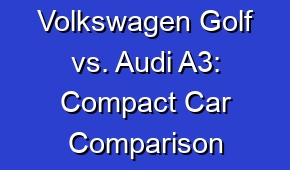Vintage Car Restoration Guide

Vintage Car Restoration Guide: Restore your classic car to its former glory with this comprehensive guide. Learn step-by-step techniques and tips to bring out the beauty of your vintage automobile. Perfect for car enthusiasts and collectors.
Looking to restore your vintage car to its former glory? Our comprehensive Vintage Car Restoration Guide is the ultimate resource for enthusiasts. With step-by-step instructions and expert tips, this guide will help you bring your beloved car back to life. Whether you’re a seasoned pro or a beginner in the world of car restoration, our guide has you covered. From choosing the right tools to tackling common challenges, we provide all the information you need to successfully restore your vintage car. Don’t let rust and wear ruin your classic beauty—get our Vintage Car Restoration Guide today and start reviving your dream ride.
| Vintage Car Restoration Guide: Tips for restoring classic cars to their former glory. |
| Learn essential techniques like bodywork, painting, and engine rebuilding. |
| Discover the best tools and equipment for vintage car restoration projects. |
| Find reliable suppliers for rare and hard-to-find vintage car parts. |
| Understand the importance of documentation and proper research for accurate restoration. |
- Tips: Choose the right restoration project that matches your skills and budget.
- Preservation: Learn techniques to preserve original features while restoring vintage cars.
- Interior: Restore the luxurious interiors of classic cars with authentic materials.
- Electrical: Get guidance on repairing and upgrading vintage car electrical systems.
- Finishing: Master the art of polishing and detailing to achieve a showroom-worthy finish.
What are the essential steps in vintage car restoration?
Vintage car restoration involves several crucial steps, starting with meticulous planning and research to determine the car’s original specifications and condition. Stripping down the car to its bare frame is necessary to assess the extent of repairs needed. Repairing or replacing damaged body panels, engine parts, and interior components is crucial. Painting and refinishing the car’s exterior is a meticulous process that requires skilled craftsmanship. Finally, reassembly and testing ensure that the car is in proper working order before it hits the road.
How do I choose the right vintage car for restoration?
When selecting a vintage car for restoration, it’s important to consider factors such as availability of parts, popularity of the model, and your budget. Researching the car’s history and production numbers can help determine its rarity and value. Inspecting the car’s condition for rust, structural damage, and mechanical issues is essential. Additionally, considering your own mechanical skills and the level of restoration required is crucial in making the right choice.
What are the common challenges in vintage car restoration?
Vintage car restoration can present various challenges, including finding rare parts or recreating unavailable ones. Dealing with rust and corrosion issues is often time-consuming and requires specialized knowledge. Restoring the car’s original interior upholstery can be challenging due to limited availability of accurate materials. Additionally, matching the car’s original paint color and achieving a flawless finish can be demanding.
How can I prevent rust in vintage cars?
To prevent rust in vintage cars, regular cleaning and waxing is essential to protect the car’s exterior. Storing the car in a dry and well-ventilated garage helps prevent moisture buildup. Applying rust inhibitors or sealants to vulnerable areas can provide an extra layer of protection. Inspecting the car for any signs of rust and addressing them promptly is crucial to prevent further damage.
What factors should I consider before repainting a vintage car?
Before repainting a vintage car, consider the original paint color and whether you want to preserve its authenticity. Choosing the right type of paint that matches the car’s era is crucial. Evaluating the condition of the car’s body and addressing any necessary repairs before painting is essential. Additionally, hiring a skilled professional or acquiring the necessary knowledge and equipment is crucial for achieving a high-quality paint job.
How can I restore a vintage car’s interior?
Restoring a vintage car’s interior involves several steps, such as removing the existing upholstery and cleaning or repairing the seat frames and springs. Replacing worn-out or damaged upholstery with accurate materials is crucial for maintaining authenticity. Repairing or refinishing the dashboard, steering wheel, and other interior components can enhance the overall appearance. Finally, reinstalling the restored interior and ensuring proper fit and functionality is essential.
What are the benefits of vintage car restoration?
Vintage car restoration offers various benefits, including preserving automotive history and reviving classic designs. It allows enthusiasts to experience the craftsmanship and mechanical simplicity of a bygone era. Restoring a vintage car also provides an opportunity to learn valuable mechanical skills and develop a deeper appreciation for automotive engineering. Finally, restored vintage cars can be cherished family heirlooms or valuable collector’s items.
How can I find authentic parts for vintage car restoration?
Finding authentic parts for vintage car restoration can be challenging, but there are several avenues to explore. Specialized vintage car parts suppliers and online marketplaces offer a wide range of options. Attending classic car shows and swap meets can provide opportunities to connect with knowledgeable enthusiasts and sellers. Joining vintage car clubs and online forums can also offer valuable insights and connections to find authentic parts.
What are the essential tools needed for vintage car restoration?
Restoring a vintage car requires a variety of essential tools, including socket sets, wrenches, and screwdrivers. Bodywork tools such as hammers, sanders, and welders are necessary for repairing and restoring the car’s body panels. Engine rebuilding tools and mechanical diagnostic equipment are crucial for addressing the car’s mechanical components. Additionally, painting and refinishing tools such as spray guns, sandpaper, and masking tape are essential for achieving a professional finish.
What are the steps to mechanically restore a vintage car?
Mechanical restoration of a vintage car involves several steps, starting with thoroughly inspecting the engine and drivetrain for any issues or wear. Cleaning, repairing, or replacing worn-out or damaged components is essential. Rebuilding the engine and addressing any necessary repairs to the transmission and suspension is crucial. Finally, tuning and testing the car’s mechanical systems ensures optimal performance and reliability.
What should I consider when choosing a vintage car restoration specialist?
When selecting a vintage car restoration specialist, consider their experience and expertise in restoring similar models. Reviewing their portfolio and reading customer testimonials can provide insights into their work quality. Discussing the restoration process and establishing clear communication is crucial. Additionally, obtaining a detailed cost estimate and clarifying the project timeline are essential factors to consider.
How long does it take to restore a vintage car?
The time required to restore a vintage car depends on several factors, including the extent of restoration needed and the availability of parts. It can range from a few months to several years. Planning and budgeting for the restoration process are crucial to determine a realistic timeline. Additionally, unforeseen challenges and complexities may arise, extending the overall restoration duration.
How can I preserve the value of a restored vintage car?
To preserve the value of a restored vintage car, proper maintenance and care is crucial. Regular cleaning and waxing help protect the car’s exterior finish. Storing the car in a controlled environment, away from extreme temperatures and humidity, is important. Documenting the restoration process and keeping records of maintenance and repairs can enhance the car’s historical and provenance value.
What are the costs involved in vintage car restoration?
Vintage car restoration costs can vary depending on factors such as the condition of the car, the extent of restoration required, and the availability of parts. Costs can include parts and materials, professional labor, specialized tools and equipment, and transportation or storage fees. It’s important to establish a comprehensive budget and get multiple cost estimates before embarking on a restoration project.
What are the safety considerations in vintage car restoration?
Safety is paramount in vintage car restoration. Wearing appropriate protective gear such as gloves, safety glasses, and respirators is crucial when working with chemicals, paints, or power tools. Proper ventilation in the workspace is essential to avoid exposure to harmful fumes. Following electrical safety precautions when working on the car’s wiring is important. Additionally, using sturdy jack stands and adhering to proper lifting techniques ensure a safe working environment.
How can I finance a vintage car restoration project?
Financing a vintage car restoration project can be done through various methods. Personal savings or obtaining a personal loan are common options. Applying for a specialty car restoration loan from certain financial institutions is also possible. Seeking sponsorship or crowdfunding for the project can be considered. It’s important to carefully assess the financial implications and plan a realistic repayment strategy before committing to any financing option.
What are the legal requirements for vintage car restoration?
Legal requirements for vintage car restoration vary by jurisdiction, but common aspects include obtaining the necessary permits and licenses, registering the restored car, and complying with emission and safety regulations. It’s important to research and understand the specific requirements in your area before starting the restoration process. Consulting with local authorities or vintage car clubs can provide valuable guidance.
How can I ensure the authenticity of a vintage car during restoration?
Ensuring the authenticity of a vintage car during restoration involves various steps. Researching the car’s history and production records helps determine its original specifications. Using accurate reproduction parts or finding authentic original components is important for maintaining authenticity. Documenting the restoration process with photographs and records can provide evidence of the car’s originality. Consulting with experts or seeking authentication from reputable vintage car organizations can further validate the car’s authenticity.



















